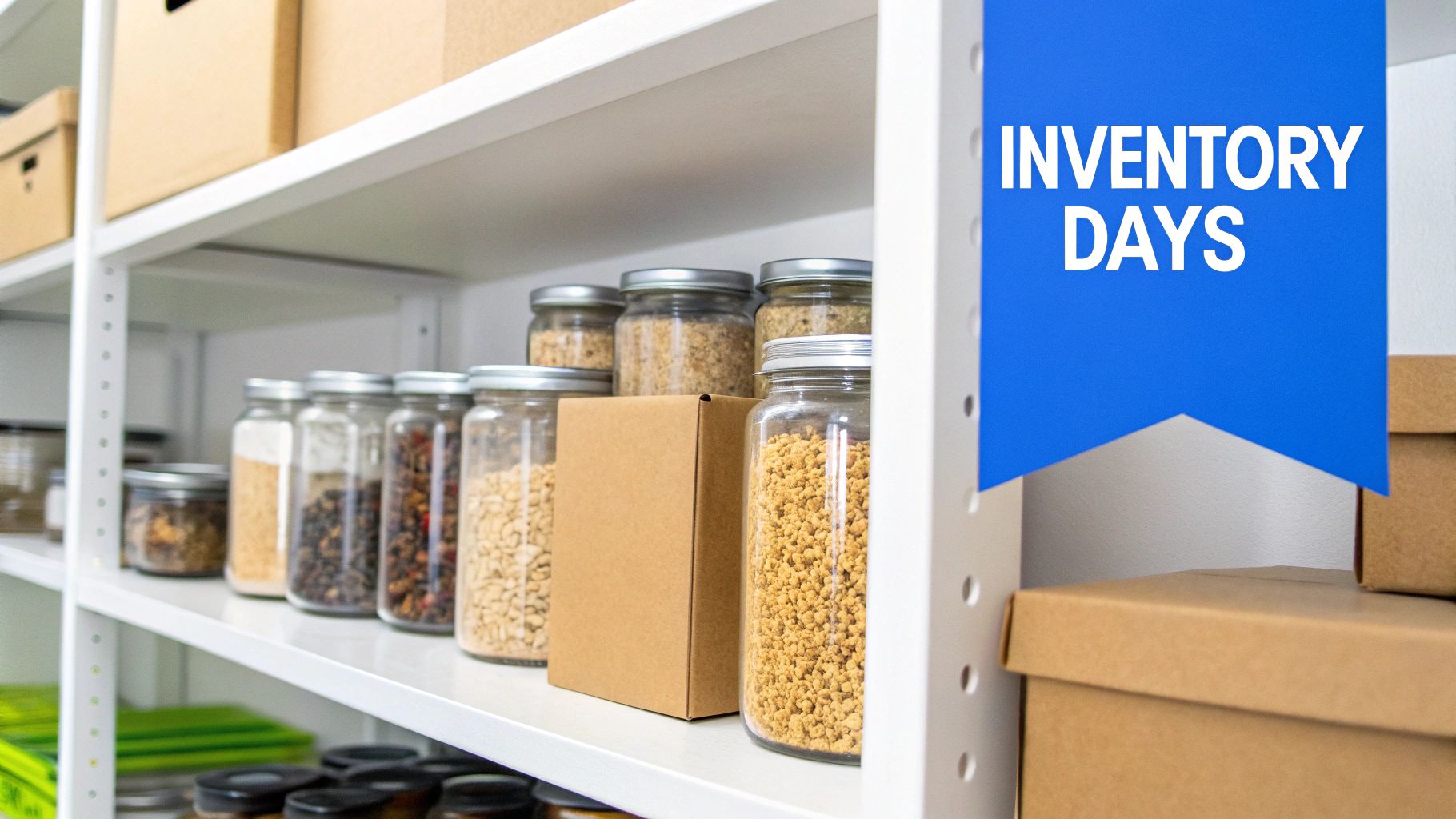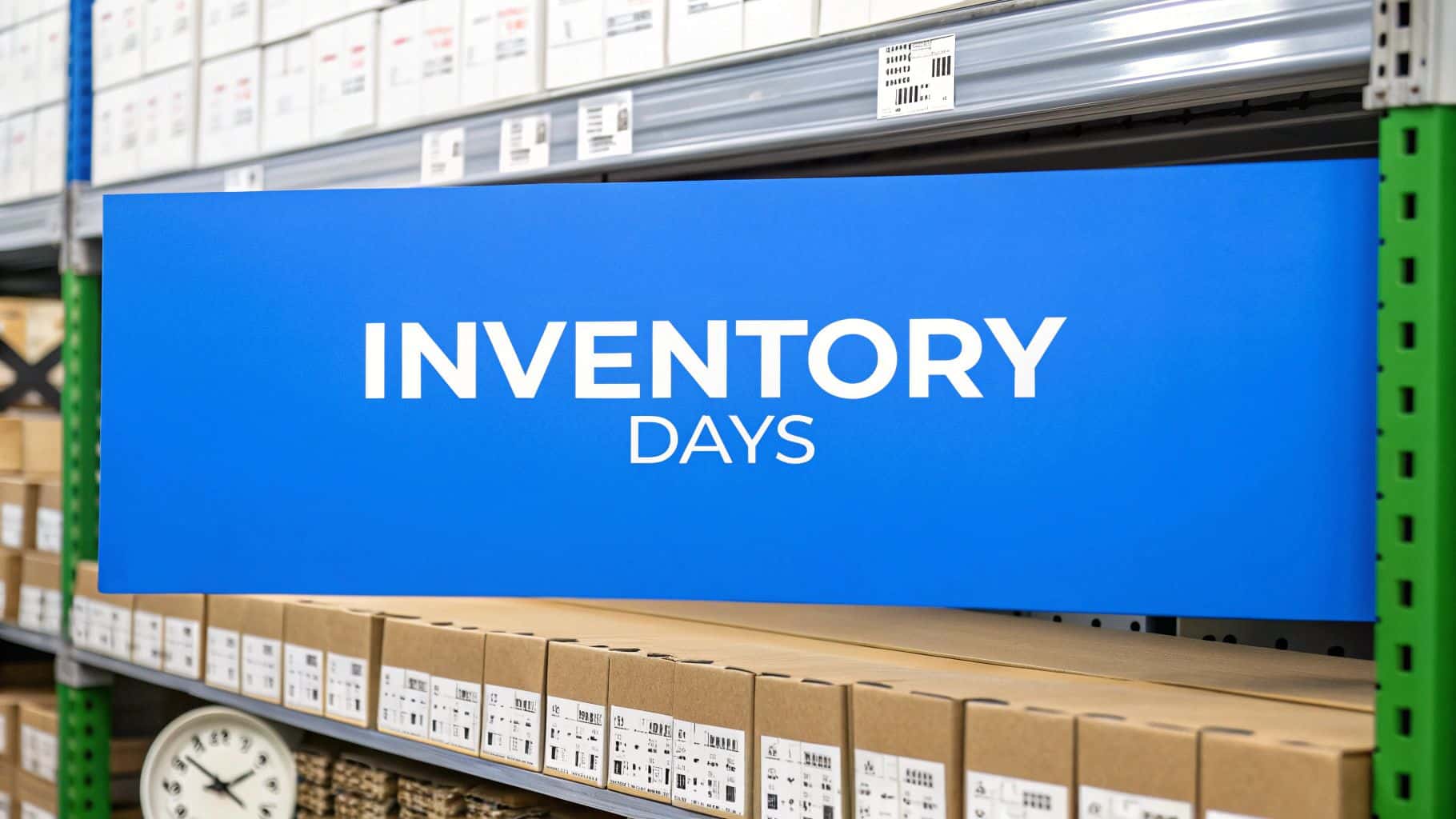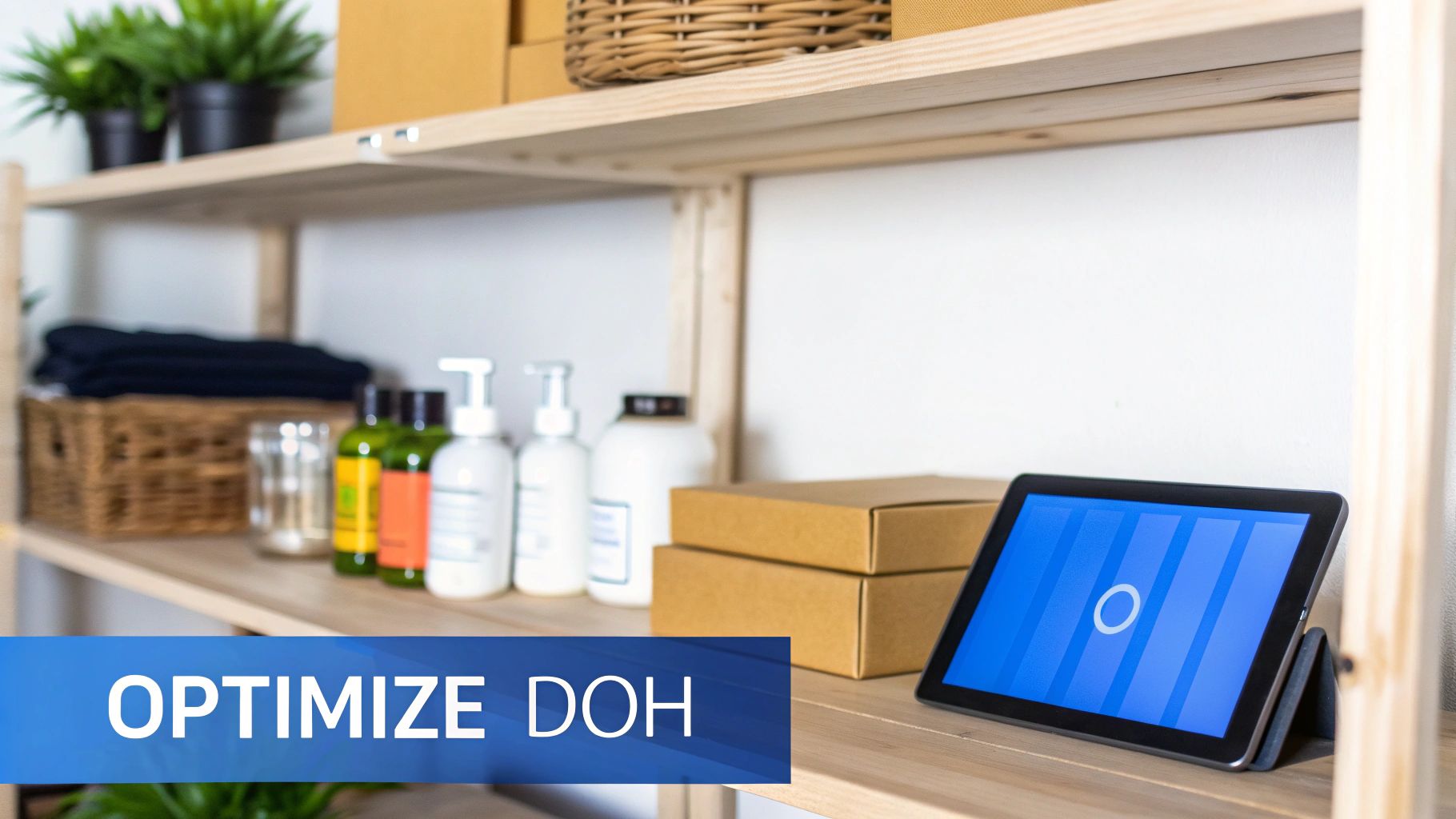The formula for inventory days on hand is deceptively simple: (Average Inventory / Cost of Goods Sold) x 365. But don't let that fool you. This number gives you a powerful snapshot of how long your business holds onto its inventory before a sale, directly reflecting your efficiency and the health of your cash flow.
Understanding Inventory Days on Hand and Why It Matters

Think of your inventory like the food in your kitchen pantry. You want enough on hand to make meals without constant trips to the store, but not so much that food goes bad or you've spent your entire budget on groceries. Inventory Days on Hand (DOH)—sometimes called Days Sales of Inventory (DSI)—is the health check for your business's "pantry."
It answers a crucial question: If you stopped ordering new stock today, how many days could you keep selling before the shelves were completely bare? It's more than just a number; it's a vital sign for the financial pulse of any company dealing with physical products.
The Balancing Act of Inventory Management
Getting your DOH right is a delicate dance. Holding on to too much inventory isn't a sign of security; it's a sign of cash being trapped. Every product gathering dust on your shelves represents money that could be driving your business forward—funding marketing, paying staff, or upgrading equipment.
On the other hand, carrying too little inventory is just as dangerous. A super-low DOH might look efficient on paper, but it means you're living on the edge of a stockout. When a customer is ready to buy and you can't deliver, you don't just lose a sale. You risk losing that customer for good.
Inventory is not just stock; it's cash sitting on a shelf. The longer it sits, the more it costs your business in storage, insurance, and missed opportunities. Optimizing your Days on Hand frees up this cash to fuel growth.
Why DOH Is a Crucial Business Metric
Keeping a close eye on your DOH gives you a direct line of sight into the core of your operations, paving the way for smarter, more profitable decisions. The way you handle your stock has a massive impact on your working capital management, a cornerstone of financial stability.
Here’s why this metric deserves your full attention:
- Better Cash Flow: Knowing how long your money is tied up in products lets you find ways to shorten that cycle, injecting much-needed liquidity back into your business.
- Lower Carrying Costs: Every extra item in your stockroom comes with costs for storage, insurance, and the risk of it becoming outdated or spoiling. A tight DOH keeps these expenses in check.
- Fewer Stockouts: Regularly checking your DOH helps you predict demand more accurately. This means fewer empty shelves, happier customers, and a protected revenue stream.
- Smarter Purchasing: The inventory days on hand formula gives you the hard data you need to stop guessing and start making strategic buying decisions, ordering the right amount at the right time.
The Core Formula for Calculating Inventory Days
At its core, the inventory days on hand formula is a simple but powerful calculation that answers a critical question: how long does my stock sit on the shelves before it's sold? Think of it as a speedometer for your inventory, measuring the efficiency of your sales cycle.
The most widely used version of the formula looks like this:
Inventory Days on Hand = (Average Inventory / Cost of Goods Sold) x 365
This equation gives you a straightforward metric—a number of days—that any business owner can use to get a quick read on inventory health. To make sure you can calculate it with confidence, let's break down each part of the formula.
Components of the DOH Formula
To get started, you need to pull together a few key numbers from your financial records. This table breaks down what each component means and where you can usually find the data.
| Component | What It Means | How to Find It |
|---|---|---|
| Average Inventory | The typical value of your stock on hand over a specific period. It smooths out daily fluctuations. | (Beginning Inventory + Ending Inventory) / 2. Find these values in your inventory records or balance sheet. |
| Cost of Goods Sold (COGS) | The direct cost of producing or purchasing the goods you sold during the same period. | Look on your business's income statement. This figure is a standard part of financial reporting. |
| Time Period (in days) | The number of days in the period you're analyzing. This is most often 365 for an annual calculation. | Use 365 for a full year, 90 for a quarter, or 30 for a month. Consistency is key. |
Once you have these numbers, plugging them into the formula is simple. The result tells you, on average, how many days' worth of sales you're holding in inventory.
Decoding Average Inventory
The first number you'll need is your Average Inventory. This isn't just a snapshot of your stock value on a random day. Instead, it represents the typical value over a set period, like a month, quarter, or year. Why the average? Because your inventory levels are constantly changing—they shoot up after a big delivery and fall as you make sales.
Using an average smooths out these highs and lows, giving you a much more reliable picture of your typical inventory investment. You calculate it by adding the inventory value at the start of the period to the value at the end, then dividing by two.
- Beginning Inventory: The total value of your stock when the period starts.
- Ending Inventory: The total value of your stock when the period ends.
This simple step prevents one unusually high or low inventory day from throwing off your entire calculation.
Understanding Cost of Goods Sold
Next, you need your Cost of Goods Sold (COGS). This figure is the total direct cost tied to the products you sold during that same time frame. It includes things like the cost of raw materials or what you paid your supplier for finished goods. It's important to remember that COGS doesn't include indirect costs like marketing, rent, or administrative salaries.
COGS is a fundamental accounting metric that tells you exactly how much it cost you to create or acquire the items your customers bought. You can usually find this number right on your income statement. The exact calculation for COGS will depend on your chosen inventory costing method, such as FIFO or LIFO.
The Alternative Formula: Using Inventory Turnover
There's another common way to calculate DOH, which is especially popular among financial analysts. This method uses the inventory turnover ratio—a metric that shows how many times you sell through your entire stock in a given period.
The alternative formula is:
Inventory Days on Hand = 365 / Inventory Turnover Ratio
This is really just a different path to the same destination. A high inventory turnover means you're selling products quickly, which logically leads to a lower number of days on hand. This version is particularly handy if your business already tracks inventory turnover as a key performance indicator.
The adoption of these formulas has been a game-changer. As supply chains went digital in the early 2000s, the inventory days on hand formula became an essential tool. Studies have shown that companies actively tracking this metric reduced their inventory carrying costs by 15-20% between 2015 and 2023. Today, the alternative formula is a go-to for 65% of financial analysts globally. For a deeper dive, you can explore the history of inventory management metrics on Razorpay.com.
Let's Calculate DOH with Real-World Examples
Knowing the theory is one thing, but seeing the inventory days on hand formula work with real numbers is where it all clicks. Let's step away from the abstract and get our hands dirty with a few calculations. By walking through different business types, you'll see how this single metric tells a completely different story depending on the industry.
We’ll look at three familiar scenarios: a retail clothing store, a local restaurant, and a neighborhood coffee shop. Each example uses realistic figures to show you not just how the formula works, but what the final DOH number actually means for the business.
Example 1: The Seasonal Retail Clothing Store
Imagine you run a boutique called "Urban Threads." Your business lives and dies by how well you manage seasonal collections. Holding onto last season's winter coats in the middle of summer is a recipe for disaster, so tracking DOH is absolutely crucial.
Let's calculate the DOH for the last quarter (90 days).
-
Figure out your average inventory. At the start of the quarter, you had $60,000 worth of stock on hand. By the end, after a busy sales season and some new arrivals, that number was down to $40,000.
- Calculation: ($60,000 + $40,000) / 2 = $50,000 Average Inventory
-
Find your Cost of Goods Sold (COGS). Pull up your income statement for that same quarter. Let's say your COGS was $110,000—this is what you paid for the clothes you sold.
-
Plug it all into the DOH formula. Now, we just pop those numbers into the formula for our 90-day period.
- Calculation: ($50,000 / $110,000) x 90 days = 40.9 days
The result of 40.9 days tells us that, on average, a piece of clothing sits on the shelf at Urban Threads for about 41 days before someone buys it. For a fashion retailer, that’s a pretty solid number. It suggests stock is moving at a healthy pace, well before it goes out of style.
Example 2: The Neighborhood Restaurant
Next up is "The Corner Bistro," a restaurant where inventory management is a daily race against the clock. Unlike clothes, ingredients like fresh produce and meat are perishable. A high DOH here isn't just a cash flow problem; it's a food waste nightmare.
Let's calculate the DOH for a single week (7 days).
-
Find your average inventory. On Monday morning, the bistro's walk-in and pantry held $8,000 in food inventory. By Sunday night, after a week of service and deliveries, it was down to $6,000.
- Calculation: ($8,000 + $6,000) / 2 = $7,000 Average Inventory
-
Calculate your Cost of Goods Sold (COGS). For that week, the total cost of ingredients used in every dish sold came to $10,500.
-
Run the numbers for the weekly period. We'll use 7 days since we're focused on one week of operations.
- Calculation: ($7,000 / $10,500) x 7 days = 4.67 days
A DOH of 4.67 days is fantastic for a restaurant. It means The Corner Bistro is selling through its entire food supply in less than five days. This is exactly what you want to see—it minimizes spoilage and guarantees every customer gets the freshest meal possible.
Example 3: The Bustling Coffee Shop
Finally, let's stop by "Morning Grind," a coffee shop juggling both perishable goods (milk, pastries) and non-perishables (coffee beans, paper cups). Here, inventory turnover happens at lightning speed.
Let's calculate their DOH for a 30-day month.
-
Get the average inventory. Morning Grind started the month with $3,000 in total stock. It ended the month with $3,500 after a big coffee bean delivery arrived.
- Calculation: ($3,000 + $3,500) / 2 = $3,250 Average Inventory
-
Find the monthly Cost of Goods Sold (COGS). For the month, the coffee shop's COGS was $15,000.
-
Apply the monthly DOH formula.
- Calculation: ($3,250 / $15,000) x 30 days = 6.5 days
A DOH of just 6.5 days shows incredible efficiency. Morning Grind is burning through its entire stock in less than a week, which is perfect for a high-volume business built on freshness. This low number proves they're using perishable items quickly and aren't tying up precious cash in bulk supplies that just sit there.
As you can see, context is everything. A "good" DOH of 41 days for a clothing store would be a complete catastrophe for a restaurant. By applying the inventory days on hand formula to your own business, you get a powerful snapshot of your operational health, tailored specifically to your industry and goals.
How to Interpret Your Inventory Days on Hand
So you've calculated your Inventory Days on Hand. What now? Getting the number is the easy part; the real magic happens when you understand the story it tells about your business. Too many owners get hung up on chasing a single "good" number, but the truth is, there's no universal ideal.
Think of your DOH as a health check for your inventory. A high number isn't automatically bad, and a low number isn't always a sign of success. Each scenario reveals something specific about how your business is operating. When you learn to read the signs, this simple metric becomes a powerful tool for making smarter, more profitable decisions.
This visual breakdown shows just how different a "healthy" DOH can look from one business to another.
As you can see, what works for a retail shop could spell disaster for a café, where fresh ingredients are everything.
What a High DOH Is Really Telling You
A high Inventory Days on Hand means your stock is lingering on the shelves for a while. Sometimes this is intentional, especially for items with long supplier lead times. More often than not, though, it’s a red flag pointing to potential problems.
- Trapped Cash Flow: Every unsold product is money you can't use for anything else—marketing, new equipment, or even just paying the bills. A high DOH means your cash is literally sitting on a shelf.
- Rising Carrying Costs: The longer you hold inventory, the more it costs you. Think storage fees, insurance, and the risk of damage or spoilage. These hidden costs can silently drain your profits.
- The Danger of Obsolescence: In fast-moving industries like fashion or electronics, a high DOH is a serious warning. Tastes change and technology advances, leaving you with outdated products you'll have to sell at a massive discount, if at all.
If you see your DOH creeping up, it’s a signal to take a hard look at what you’re buying, identify slow-moving products, and maybe run a promotion to clear out that excess stock.
The Hidden Dangers of a Low DOH
At first glance, a low DOH seems perfect. Products are flying out the door, and inventory turns over fast. It’s a clear sign of strong demand and efficient sales. But be careful—a DOH that's too low can be just as risky as one that's too high.
A very low DOH can be a warning sign of impending stockouts. While it reflects strong sales velocity, it also means you have a razor-thin buffer to handle unexpected demand spikes or supply chain delays, putting customer satisfaction at risk.
Running too lean can backfire in a few painful ways:
- Lost Sales Opportunities: The moment a customer asks for something you don't have, they're likely walking over to your competitor. That's a sale you'll never get back.
- Eroding Customer Trust: Nothing frustrates a loyal customer more than finding their favorite item is constantly out of stock. It makes your business seem unreliable.
- Spiking Shipping Costs: To avoid stockouts, you might find yourself placing frequent, small orders or paying extra for expedited shipping, both of which drive up your operational costs.
Finding Your Sweet Spot: Using Industry Benchmarks
So, what should you be aiming for? The best approach is to compare your DOH against industry averages and, just as importantly, your own past performance.
Here’s a look at how benchmarks can vary, giving you a better feel for where your business fits in.
Industry Benchmarks for Inventory Days on Hand (DOH)
| Industry | Typical DOH Range | Reasoning |
|---|---|---|
| Restaurants & Cafes | 15-25 Days | Perishable ingredients and fresh produce require extremely fast turnover to minimize spoilage and waste. |
| Grocery Stores | 20-30 Days | A mix of perishable goods (like produce) and shelf-stable items (like canned goods) creates a slightly longer but still tight window. |
| Fast Fashion Retail | 30-60 Days | Trends change rapidly, so moving clothing quickly is critical to avoid marking down out-of-style items. |
| Electronics Retail | 40-75 Days | Technology becomes outdated quickly, but higher-value items and complex supply chains lead to a longer DOH than fashion. |
| Furniture Stores | 80-120+ Days | High-ticket items with slower sales cycles and often long manufacturing lead times result in a much higher DOH. |
These numbers are a great starting point, but they aren't rigid rules. A deep dive into 2,000 companies revealed that businesses maintaining a DOH between 40-50 days saw profit margins 18% higher than those with a DOH over 80 days. Every business is unique, so tracking your own trends over time is key.
To get the full picture of your inventory's health, it’s also wise to learn how to calculate inventory turnover. This metric is the other side of the DOH coin, showing how many times you sell through your entire inventory in a period. You can explore this relationship further in our complete guide to inventory turnover. Tracking both gives you a much clearer, more actionable view of how well your inventory is performing.
How to Actually Improve Your Days on Hand
Knowing your Inventory Days on Hand is one thing, but actually doing something about it is where the real money is made. A lower DOH frees up your cash, cuts down on waste, and makes your whole business more nimble. Getting there isn't just about knowing the number; it's about having a smart, practical game plan.
Think of this section as a toolkit filled with proven tactics to get your inventory levels just right. From smarter buying habits to better sales strategies, these tips will help you find that sweet spot between keeping customers happy and running a lean operation.
Fine-Tune Your Ordering with Data
Guesswork is the arch-nemesis of good inventory management. The single best way to bring your DOH down is to stop buying based on a gut feeling and start making decisions based on cold, hard data. And that all starts with your own sales history.
Digging into your sales data helps you build a much more accurate demand forecast. You can spot your bestsellers, see how sales change with the seasons, and identify which products are just collecting dust. When you buy based on what your customers actually do, you stop tying up cash in stock that isn't going anywhere.
Here's how to start:
- Analyze Sales Reports: Make it a habit to look at your POS reports. What's selling? And when?
- Identify Trends: Do certain cocktails fly out the door only in summer? Do specific retail items sell best around the holidays? Look for these patterns.
- Segment Your Inventory: Group your products into categories: fast-movers, slow-movers, and seasonal items. Each group needs its own ordering strategy.
Implement Smart Reordering Systems
Once you've got a handle on your sales patterns, you can set up systems to avoid both overstocking and running out of popular items. A simple but powerful tactic is setting a reorder point for every product you carry.
A reorder point is just the minimum stock level an item can hit before you absolutely need to place a new order. It’s a proactive approach that takes the stress and guesswork out of restocking.
Think of automated reorder points as a safety net for your inventory. You give yourself enough lead time for a new shipment to arrive before you run out, preventing lost sales while keeping your backroom from overflowing.
This is where a good restaurant inventory management system becomes your best friend. These tools can track your stock levels in real-time and ping you the moment an item hits its reorder point, making the whole process incredibly accurate and almost effortless.
Embrace a Just-in-Time Approach
If you're ready to take efficiency to the next level, look into the Just-in-Time (JIT) inventory model. The whole idea behind JIT is to get goods from suppliers only as you need them for production or sales. It’s a fantastic way to slash your holding costs.
While a full-blown JIT system requires rock-solid supplier relationships and laser-sharp forecasting, you can still borrow its core principles. Try reducing your order sizes and ordering more frequently for your fastest-selling items. This keeps your stock lean and helps you react quickly to changes in customer demand.
Liquidate Slow-Moving and Obsolete Stock
Let’s be honest—every business has those products that just won't sell. This "dead stock" is a huge drain, locking up cash and taking up precious shelf space. A high DOH is often a direct result of ignoring this stuff.
Here are a few ways to clear out that underperforming inventory:
- Promotional Sales: Bundle slow-movers with popular items or offer a steep discount to get them out the door.
- Clearance Events: Run an end-of-season or flash sale to move old inventory and make room for the new.
- Employee Incentives: Give your staff a small bonus for every slow-moving item they sell. A little motivation goes a long way.
The cash you unlock from liquidating this old stock can be put right back into buying more of what your customers truly want. This one cleanup can do wonders for both your DOH and your bank account.
Finally, don't forget to talk to your suppliers. Building a strong relationship can lead to better terms, like shorter delivery times or smaller minimum orders. A supplier who can get you smaller batches more often is a crucial ally in the fight for a lower DOH. These small tweaks in your supply chain can create a ripple effect, leading to a much more efficient and profitable business.
Common Questions About the DOH Formula
Once you get the hang of the calculations, you'll find a few common questions still pop up. It's perfectly normal. Let's tackle these lingering queries to make sure you're fully confident in using this powerful metric.
Think of this as your go-to reference for those "what if" scenarios that business owners run into all the time. These insights will firm up your understanding and get you ready to use DOH like a pro.
What Is a Good Number for Inventory Days on Hand?
This is the big one, but the honest answer is: it depends. There’s no universal “good” number for DOH. What spells efficiency for one type of business could signal a major problem for another.
For instance, a grocery store with fresh produce might aim for a DOH around 20 days to keep spoilage in check. On the other hand, a car dealership could be running smoothly with a DOH of 60 days, simply because cars are high-value items that take longer to sell.
The best strategy is to stop searching for a magic number. Instead, measure your DOH against two things that actually matter: your industry's average and your own past performance. That's how you get the right context to make smart decisions.
How Often Should I Calculate My DOH?
The right rhythm for calculating DOH really comes down to how fast your business moves. For most retail or service businesses, running the numbers monthly or quarterly works just fine. It’s frequent enough to spot trends without getting bogged down in admin work.
But if you're in a faster-paced industry, you'll need to check in more often.
- Businesses with perishable goods, like restaurants and cafes, should probably calculate DOH weekly, if not bi-weekly.
- Industries with quick-changing trends, like fast fashion, also need more frequent calculations to avoid getting stuck with last season's stock.
Can My Inventory Days on Hand Be Too Low?
Yes, absolutely. A low DOH usually points to great sales and efficiency, but an extremely low number is a serious warning sign. It often means you're operating with a paper-thin inventory buffer, putting you at high risk of running out of popular items.
It’s like driving your car with the fuel light always on. Sure, you're running lean, but a single unexpected delay—a supplier issue or a sudden spike in demand—could bring everything to a halt.
Stockouts don't just cost you a single sale. They create frustrated customers who might not come back, which can hurt your brand's reputation in the long run. The sweet spot is finding that balance between lean operations and having enough stock to keep your customers happy.
How Is DOH Different From Inventory Turnover?
Inventory Days on Hand (DOH) and Inventory Turnover are two sides of the same coin. They both measure inventory efficiency, just from different angles. They have an inverse relationship, and looking at them together gives you the full story.
Let's use an analogy. Imagine you have a full glass of water.
- Inventory Turnover tells you how many times you could drain and refill that glass in a year. A high number (like 12 times) is great.
- Inventory Days on Hand tells you how many days it would take to drink that single glass. A low number (like 30 days) is what you're aiming for.
So, if your inventory turnover is 12 times a year, your DOH is about 30.4 days (365 days / 12). A high turnover always means a low DOH, and vice versa. One measures frequency (how often), while the other measures time (how long).
Stop guessing and start optimizing with data-driven insights. Biyo POS offers a powerful, all-in-one system that automates your inventory tracking, simplifies sales analysis, and gives you the real-time data you need to perfect your Days on Hand. Take control of your inventory today with Biyo POS and turn your stock into a strategic asset.







